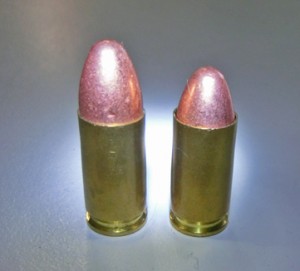Came home from a long day, getting ready for bed. Pulled my holstered gun off my belt and locked it into the quick-access bedside safe — yep, still in its holster. Still loaded. It’s secure, and also ready to go should I need it.
I’m not a big fan of unnecessarily unloading and reloading my carry gun.
Why not? Because I don’t want my ammunition to suffer from setback. And because I do not want to risk killing the primer without knowing I’ve done it.

The round of ammunition on the left is healthy and it is exactly the length it should be. The one on the right has suffered from setback, making it significantly shorter.
As you load a round of ammunition into a semi-automatic gun and then remove it from the chamber without firing, the bullet naturally tends to get pushed back slightly into its case. When this happens, the compressed powder can[ref]Note the word can. This is not to say it necessarily does, in every case. There are informal but popular “research” papers that say this isn’t a big deal, on the basis of one backyard test with a hammer and no way to measure the pressure inside the round. But on the other hand there are also many, many first-hand reports of setback being a factor in exploded guns, including several that come from law enforcement agencies that investigated multiple incidents. And there are even graphs and things that explain the science behind this. (Also see: Normalization of Deviance.) A single exemplar of a gun that failed to explode as expected does not overcome the weight of experience and the science that says setback-induced overpressure can indeed be a factor to respect.[/ref] create much higher pressures inside the chamber than the gun is designed to handle. The result can be a bit … messy. Also expensive and painful.
Loading, unloading, and reloading the same round can also cause the primer mix inside the case to get knocked out of place, a problem you won’t be able to see by looking. But the missing primer mix means the round simply will not fire when you need it.
When a self-defense gun fails to fire, the results can be catastrophic for the person who was relying on it to save their life.
What to do about this? I love this advice from Chuck Haggard of Agile Training and Consulting.
“If you simply must unload/reload daily … I strongly urge you to not re-chamber the same round more than 2-3 times, and to keep track of this to mark the round coming out of the chamber with a Sharpie so that you know how many times it’s been chambered. A tic mark on the rim of the case is easy to do, and easy to see.”
This seems to be an easy solution. Avoid unloading and reloading your gun whenever possible. But when you must, keep track of how many times you’ve done it. Simple.
Summing up:
- Avoid loading, unloading, and reloading the same round multiple times.
- Keep track of the number of times one round has been through the process by putting a small mark on the side of the case each time it comes out of the chamber.
- When one round has been loaded and unloaded more than a handful of times, take it to the range and shoot it during practice. Do not continue to load and unload that round for self defense.
One round of ammunition costs around 50 cents. One new handgun costs around $500. And one life is priceless.
Stay safe.





Pingback:A slight setback — Cornered Cat | WyldKat's Lair
Pingback:Weekend Knowledge Dump- February 16, 2018 | Active Response Training
Pingback:KR Training February 2018 newsletter – Notes from KR